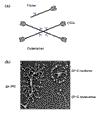Surfactant protein-D and pulmonary host defense
- PMID: 11667972
- PMCID: PMC59549
- DOI: 10.1186/rr19
Surfactant protein-D and pulmonary host defense
Abstract
Surfactant protein-D (SP-D) participates in the innate response to inhaled microorganisms and organic antigens, and contributes to immune and inflammatory regulation within the lung. SP-D is synthesized and secreted by alveolar and bronchiolar epithelial cells, but is also expressed by epithelial cells lining various exocrine ducts and the mucosa of the gastrointestinal and genitourinary tracts. SP-D, a collagenous calcium-dependent lectin (or collectin), binds to surface glycoconjugates expressed by a wide variety of microorganisms, and to oligosaccharides associated with the surface of various complex organic antigens. SP-D also specifically interacts with glycoconjugates and other molecules expressed on the surface of macrophages, neutrophils, and lymphocytes. In addition, SP-D binds to specific surfactant-associated lipids and can influence the organization of lipid mixtures containing phosphatidylinositol in vitro. Consistent with these diverse in vitro activities is the observation that SP-D-deficient transgenic mice show abnormal accumulations of surfactant lipids, and respond abnormally to challenge with respiratory viruses and bacterial lipopolysaccharides. The phenotype of macrophages isolated from the lungs of SP-D-deficient mice is altered, and there is circumstantial evidence that abnormal oxidant metabolism and/or increased metalloproteinase expression contributes to the development of emphysema. The expression of SP-D is increased in response to many forms of lung injury, and deficient accumulation of appropriately oligomerized SP-D might contribute to the pathogenesis of a variety of human lung diseases.
Figures

References
-
- Crouch EC. Collectins and pulmonary host defense. Am J Respir Cell Mol Biol. 1998;19:177–201. - PubMed
-
- Wright JR. Immunomodulatory functions of surfactant. . Physiol Rev. 1997;77:931–962. - PubMed
-
- Sumiya M, Summerfield JA. The role of collectins in host defense. Semin Liver Dis. 1997;17:311–318. - PubMed
Publication types
MeSH terms
Substances
LinkOut - more resources
Full Text Sources
Other Literature Sources

